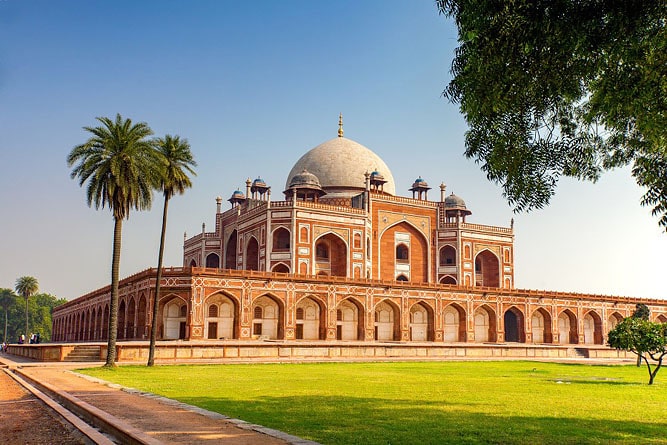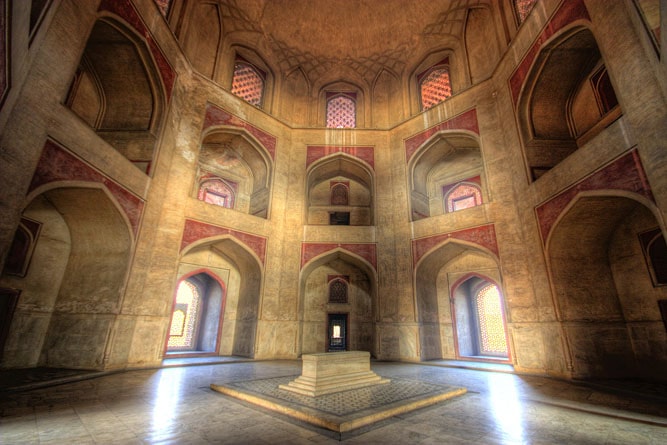Humayun's Tomb
Historical monument in Delhi
must-see attraction
Opening hours: dawn-dusk
Address: Mathura road, Nizamuddin East, Delhi
Ticket price: Indian/foreigner ₹40/600, video ₹25
Visit duration: People typically spend 1 to 1.5 hours here


About Humayun's Tomb, Delhi
Located in Nizamuddin East, Humayun's tomb is one of the most visited tourist attractions in Delhi.
The architecture of the tomb echoes what might have been the very first attempt at the contemporary concept of minimalism. The mausoleum of Humayun marks the beginning of the Golden Age of Art and Architecture created by the Mughal empire so that their legacy could be embraced by posterity.
The tomb was recognised as a World Heritage Site by UNESCO in 1993.
History of Humayun's Tomb
Humayun's Tomb was built between 1565 and 1572. The lofty appearance of the tomb is a reflection of the heritage of the Mughal Empire.
Humayun, the second Mughal ruler of India passed away at a fairly young 47 years. He was buried in his palace, Purana Quila after his death. In 1558, his remains were moved to Sirhind in Punjab by Khanjar Beg and looked after by his son, the third Mughal empire, Akbar.
Humayun's first wife, Empress Bega Begum, was devastated by his sudden death. She was in grief and decided to dedicate her life to building a memorial for her husband. Architect Mirak Mirza Ghiyas from Herat was chosen by Beda Begum to build Humayun's Tomb. He died before the architecture was complete and his son, Sayyed Muhammad ibn Mirak Ghiyathuddin took in the responsibility.
The expenses of the tomb were ₹1.5 million which were funded by Bega Begum. She even looked after the entire process of construction. The tomb was fully completed 16 years after Humayun's death.
The decline of the Mughal empire turned the mausoleum into a shelter for refugees. Without maintenance, the exteriors started becoming damaged. Lord Curzon once tried to reconstruct the mausoleum to its old form. However, he changed the Persian style of the garden into an English-styled garden. After India’s Independence, many attempts were made to restore the regal countenance of Mughal architecture.

Architecture of Humanyun's tomb
The majestic and grandeur atmosphere of the Mughal empire is reflected through the 30 acres site of Humayun's Tomb. The architecture of Humayun's tomb took the spotlight on Persian designs and patterns on Indian soil. The Islamic architecture combined red stones and white marble stones enclosed by a green pasture field with tall trees and shrubs reflects the elegance of Mughal architecture.
While entering the tomb from west and south, the pavement passes through two lofty storied gateways. The garden around the gigantic tomb was the first attempt to mimic the image of the garden of paradise mentioned in the pages of the Quran. The garden is known as the Char Bagan because it is a huge garden in four parts by stone-carved pavements.
The plinth of the tomb is 21 feet high and 299 feet wide. The cells and the terrace of the plinth house 100 gravestones of the Mughal family. The fences of the roof and the windows of the tomb exhibit the stone latticeworks. The tomb is settled in the centre of the plinth. It is 154 feet tall with a gigantic-cosmic dome at its top that was influenced by Persian architecture.
The tomb is octagonal and enveloped in a nine-fold structure. Eight vaulted chambers are interconnected with each other at the main chamber that holds the cenotaph of the Humayun. The walls of the tomb are clad with red and yellow sandstones and marble white and black stones. These are in contrast with the mosaic-like flooring of the cavernous interior. At the centre is the white marble cenotaph with designs and inscriptions carved on it. Around the cenotaph, the black and white flooring depicts an octagonal shape that perceives the star-like pattern.
The cenotaphs of the Mughal family lying adjacent to Humayun's one also has inscriptions and carved designs. The symbol of writing instruments denotes that the tomb belongs to a male while writing slate carvings indicates it to be of a woman.
The layout of the tomb implements the Rajasthani design of corbel brackets, stone latticeworks and chhatris-feature fused with the pendentive structure or Persian-styled dome.
Other monuments in the complex
- The tomb and mosque of Isa Khan is an octagonal monument that was constructed 20 years prior to the construction of Humayun's tomb. It belongs to an Afghan Noble, Isa Khan Niyazi of the Suri dynasty and his entire family. The three-bay-wide mosque stands on the western side of Humayun's Tomb.
- Bu Halima's tomb and Garden lie near the west entrance, but the position of the tomb suggests that it was added later to the garden.
- Afsarwala tomb and mosque located at the southeast end were built to pay tribute to the owner of the tomb. The mosque belongs to the same period of 1556-67 as mentioned on the graves lying adjacent to it.
- Arab Seria was constructed under Bega Bedum's authority in 1560-1561 C.E. that could lodge 300 Arabas.
- Nila Gumbad (the Blue Dome) was built by Abdul Rahim Khan-I-Khana, son of Bairam Khan, a Mughal courtier. It was built in memory of his servant Miyam Fahim. The tomb is known for its square-shaped room enveloped by the exterior octagonal structure.
- Barber's Tomb with the inscriptions 1590-91 and verses from the Quran is known as Nai-ka-Gumbad. It is a double dome with a single compartment that is said to belong to a royal barber.
- Chillah Nizamuddin Aulia, dated 1325 is located at the northeastern corner of Humayun's Tomb and was the residence of the patron saint of Delhi, Nizamuddin Auliya. The structure is an example of Tuglaq architecture.
Other attractions are located further away from the main mausoleum. The tomb of Muzaffar Husain Mirza, Bada Bateshewala Mahal, who was the grand-nephew of Humayun, had its interior walls decorated with painted plasters and five arches on each side. The bridge with 12 piers and 11 arched openings, Barapula, was built by Mihr Banu Agha, the chief eunuch of Jahangir's court in 1621. The Chote Bateshewala Mahal had a dome ceiling and jaalis architecture.

Entry fee and timings
The historic site is open throughout the week from sunrise to sunset but to be more specific the time will be 8:00 am to 6:00 pm.
The entry fee for Indian tourists is ₹40 and for foreign tourists, it is ₹600. The site does not charge any money for photography but for filming inside you have to pay a nominal fee of ₹25.
Facts and tips about Humayun's Tomb
- Humayun's Tomb is the first architecture to use red sandstone on an immense scale and the first garden-based tomb in the Indian subcontinent.
- In 1611, an English merchant visited Humayun's Tomb and documented the interior decoration of the mausoleum which contrasts with the empty chambers of the tomb in the present day. He documented that the cenotaph was covered by a white shamiana and there were rich carpets and copies of the Quran along with the king's sword, turban and shoes beside it.
- You can spot the gravestones of Humayun's wives, Bega Begum and Hamida Begum, in the complex.
- The crowd during the week can be avoided by visiting the place either early in the mornings or the late afternoons while the weekends attract a lot of visitors.
How to reach Humayun's Tomb
Humayun's Tomb is located near the India Gate, about 10 minutes by car from Connaught Place. It is also reached in 10 minutes from the Lotus Temple. The Red Fort and Jama Masjid are a 20-minute drive from Humayun's Tomb.







See location on Google Maps
Other attractions near Humayun's Tomb
- Connaught Place - 5.6 km
- Lotus Temple - 5.8 km
- Jama Masjid - 7.0 km
- Red Fort (Lal Qila) - 7.5 km
- Qutb Minar - 13 km
FAQs about Humayun's Tomb
1. How many tombs are there other than the tomb of Humayun?
The place is also known as ‘the dormitory of the Mughals’ as it houses 150 more tombs of Humayun.
2. Can aged people or those with knee problems visit Humayun's Tomb, Delhi?
Yes, aged people and those who can’t walk can visit the tomb. However, to see the main cenotaph you have to climb stairs.
3. Is it necessary to hire a guide?
No, it is not necessary to hire a guide as the monuments have plaques that are sufficient for the tour but you can hire one if you want.
4. Are there any good places to eat near the tomb?
Yes, there are a lot of restaurants and cafes near the place. Food items are not allowed inside the historical site.

